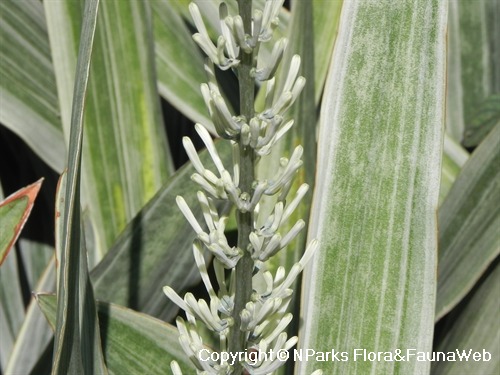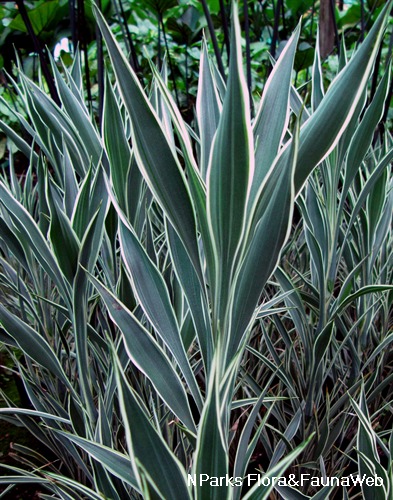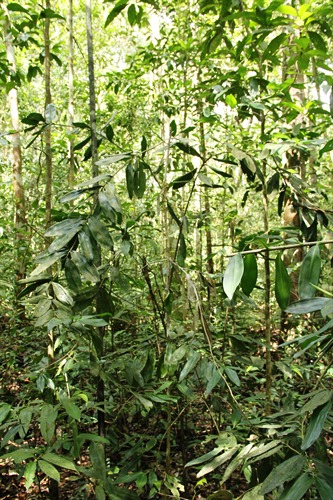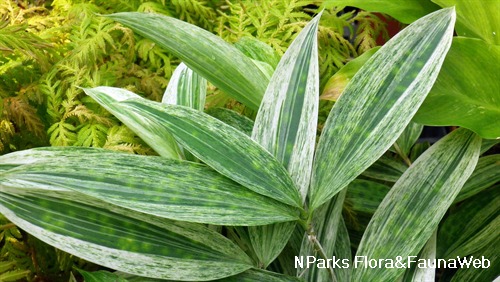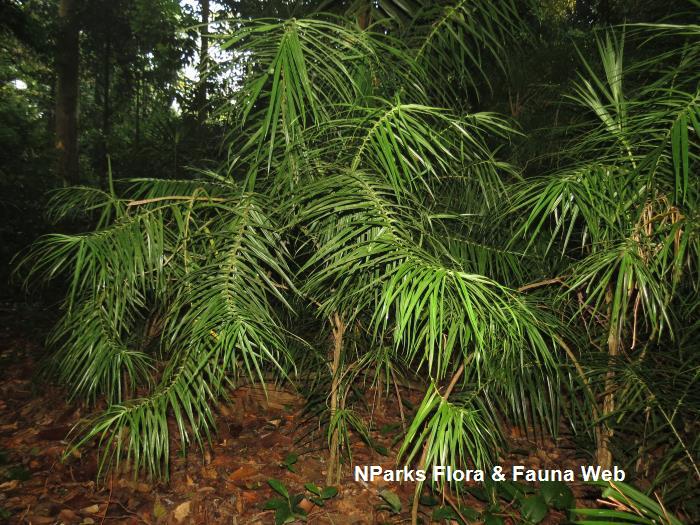
Back
Dracaena zebra 'Siam Silver'
| Family Name: | Asparagaceae |
| Synonyms: | Sansevieria metallica 'Siam Silver' |
| Common Name: | Snake Plant, Good Luck Plant, Mother-in-law's Tongue |
Name
Classifications and Characteristics
| Plant Division | Angiosperms (Flowering Seed Plants) (Monocotyledon) |
|---|---|
| Plant Growth Form | Succulent Plant |
| Lifespan (in Singapore) | Perennial |
| Mode of Nutrition | Autotrophic |
| Maximum Height | 0.6 m |
Description and Ethnobotany
| Growth Form | Rhizomatous succulent occurs in small clumps. |
|---|---|
| Foliage | Linear, pointed leaves occur in rosettes. Leaves are stiff, leathery and held erect (0.5 - 0.8 m long, 3 - 6 cm wide). They have a vertical striping pattern of grey and greyish green bands of varying width. Horizontal bands of light greyish green cross through the greyish green vertical bands. |
| Flowers | Fragrant flowers are arranged on tall spike inflorescences (0.5 - 0.7 m). On rare occasions, this cultivar blooms in hot weather. |
| Cultivation | This cultivar is very hardy and requires little maintenance. Plant in loamy or sandy soil that has good drainage. For potted plants, use a soilless mix. It is important to avoid watering too much, so allow the soil to dry before re-watering. Fertilize every 2 months with a liquid or dry 3-1-2 NPK fertilizer that contains trace elements. Try to avoid repotting the plant unless it's really needed. This plant is susceptible to rot caused by the bacteria Erwinia spp. and the fungi Aspergillus niger and Fusarium moniliforme. |
| Etymology | The genus "Sansevieria" was named after Count Pietro Antonio Sanseverino of Naples, Italy. He was a patron of horticulture during the late 1700s. The species epithet "metallica" refers to the silver-coloured leaves. |
Landscaping Features
| Landscaping | The erect, pointed leaves of this cultivar have a striking form that attracts interest. The tall leaves will provide a contrast in height when planted next to shorter succulents. This cultivar looks best when several individuals are planted together in groups. They look attractive next to walls, on windowsills or in mixed plantings with other succulents. It is sometimes used as edging along pathways. This cultivar will grow indoors or outdoors and in pots or in the ground. It can tolerate partly shady and dry locations. |
|---|---|
| Desirable Plant Features | Ornamental Foliage |
| Landscape Uses | Interiorscape/ Indoor Plant, General, Flowerbed / Border, Container Planting |
| Thematic Landscaping | Silver Garden |
| Plant & Rootzone Preference or Tolerance Remarks | Sandy soil |
Plant Care and Propagation
| Light Preference | Full Sun, Semi-Shade |
|---|---|
| Water Preference | Little Water |
| Plant Growth Rate | Slow |
| Rootzone Tolerance | Easy to Grow, Drought Tolerant, Fertile Loamy Soils, Well-Drained Soils, Shallow Media |
| Maintenance Requirements | Low |
| Propagation Method | Division |
| Propagation Method Remarks | Propagate by dividing the rhizome. Use a knife to divide the rhizome of a dormant individual into several pieces that each contain healthy roots and at least 1 growing point. Any part of the rhizome that is woody or damaged should be removed. Apply fungicide to the cut surfaces and allow calluses to form. Place the sections in cactus potting compost for 3 - 5 days, and then begin to water the plant. |
Foliar
| Foliage Retention | Evergreen |
|---|---|
| Mature Foliage Colour(s) | Silver / Grey, Green |
| Mature Foliage Texture(s) | Smooth, Leathery |
| Foliar Type | Simple / Unifoliate |
| Foliar Arrangement Along Stem | Rosulate / Rosette |
| Foliar Shape(s) | Non-Palm Foliage (Linear) |
| Foliar Venation | Parallel |
| Foliar Margin | Entire |
| Foliar Apex - Tip | Acute |
| Foliar Base | Truncate / Square |
| Typical Foliar Area | Mesophyll ( 45cm2 - 182.25 cm2 ) |
Non - Foliar and Storage
| Stem Type & Modification | Acaulescent |
|---|---|
| Root Type | Underground (Fibrous Root) |
| Specialised Storage Organ(s) | Aboveground |
Floral (Angiosperm)
| Flower Colour(s) | Cream / Off-White |
|---|---|
| Flower Grouping | Cluster / Inflorescence |
| Flower Symmetry | Radial |
| Individual Flower Shape | Stellate / Star-shaped |
| Inflorescence Type | Spike |
| Flowering Period | Rarely |
| Flowering Opening Time | Night (dusk to dawn) |
| Flowering Habit | Polycarpic |
Image Repository
Others
| Master ID | 30359 |
|---|---|
| Species ID | 4668 |
| Flora Disclaimer | The information in this website has been compiled from reliable sources, such as reference works on medicinal plants. It is not a substitute for medical advice or treatment and NParks does not purport to provide any medical advice. Readers should always consult his/her physician before using or consuming a plant for medicinal purposes. |


